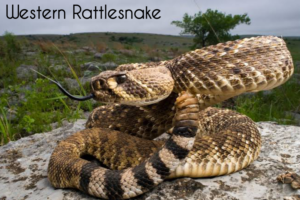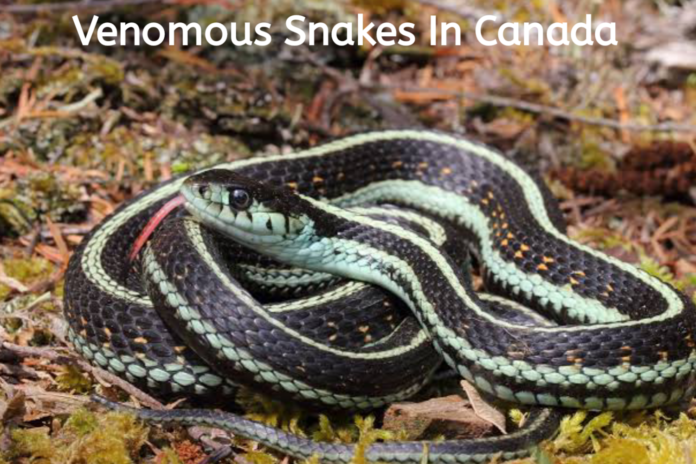Canada is a country known for having over 30 species of snakes, both indigenous and otherwise, but has only recorded three deaths due to snake bites in history, and among those three recorded, the last one happened about 40 years ago, so this made people wonder, Are there any venomous snakes in Canada? This is the question on the lips of most people, and for you to be on this page means you are also seeking an answer to this same question, right? Don’t worry, you are on the right page. Just keep reading, and you will get the best answers.

Finding out that there are venomous snakes in Canada should not make you live in fear of being bitten. For as long as you mind your business and try not to attack them, they will also not bite you; in fact, they try to avoid contact with people, which tells you they are not troublesome and that they only bite someone out of self-defense, that is, when being frightened or attacked. Venomous snakes are dangerous, and that’s why I advise you not to disturb them if you see them. Always give them their space because they could easily react when agitated.
I know you are here because you want to know if any dangerous snakes live near you and what they look like, so here is the truth: there are three venomous snakes in Canada, and that’s what we are going to discuss here.
1. Western Rattlesnake:

Another name for this snake is Crotalus atros or the Northern Pacific Rattlesnake. It is found in different places, like grassland and woodlands, and is one of those snakes that is comfortable living close to humans. They don’t maintain one color, as they camouflage into the color of the grass or shrubs they find around them.
The females give birth to live and not laid eggs and can birth 25 little ones at once. They are always alert in a curled manner, waiting for their prey, and they always feed on small mammals, amphibians, reptiles, and even birds of different species. Adult Northern Pacific Rattlesnakes can be up to 6 feet in length, although in general they vary. The color too varies, as you can find them looking olive-brown, dark brown, or yellowish, but to have a clearer view, I recommend you look closely at the image above.
2. Prairie Rattlesnake:

Crotalus viridis, as it is also called, dwells in provinces of southern Canada, forest environments, open prairies, and semi-desert shrublands. They are quite shy if approached and will quietly crawl to take cover. They will always freeze, camouflage to get you confused, and coil and rattle their tail as a warning before striking.
They chose to hibernate in a communal den, more like a den or rock crevice, during the winter with other species of snakes, and they disappear in the spring. They rarely pour their venom, but once they do, it has both neurotoxic and hemotoxic properties that can be harmful to humans. Their adults typically range between 3 and 5 feet in length, and as for coloration and every other thing you may want to know, looking at the image above will be very helpful.
3. Eastern Massasauga:

They typically live in wet habitats like the Great Lakes area of Canada, floodplain forests, wet prairies, shrub swamps, moist grasslands, and marshes. They are also called Sistrurus catenatus and will always migrate to drier regions during the summer.
Unlike rattlesnakes, Eastern Massasauga frequently hibernates alone in crayfish burrows or tree roots, and to avoid freezing to death, dens must be below the frost line. They are also shy and avoid contact with humans, but they are venomous and can bite when attacked or accidentally stepped on. They have a poisonous venom called cytotoxic that can damage cells and tissues, disrupt blood flow, and also prevent clotting.
Are Snake Bites Common In Canada?
When humans and snakes interact, it often results in a bite. Some of them are venomous and tend to be poisonous when they bite, but the truth is that most snakes avoid people and only bite when they are being toyed with.
Canada has only three venomous snakes that one should be concerned about, but living in Canada, should one be worried about snake bites? We will find out soon.
Canada has snakes in less than 50% of their provinces, but only 99 snake bite cases were recorded in Canada from 2009 to 2015, and in the last 50 years, of all the serious snake bite cases recorded, only 2 resulted in death. In a whole year, Canada gets around 100 snake bite reports, even though over 155,000 snakes are kept as pets in Canada. These statistics show that snake bites are not common in Canada and rarely result in death, having recorded only three deaths in history.
How Do You Keep Snakes Away?

For about 150 million years, snakes have existed on the planet, causing havoc to both humans and other livestock in general. These legless and scaly animals are probably not ones you would want to share your environment with, but ironically, those things that make you settle comfortably in your home might also attract snakes, like shade, clean natural water, and your overall clean surroundings. While most snakes you encounter are harmless, most of us still don’t want to have them around our homes. Snakes need a comfortable place to stay, feed, and breed, and they wouldn’t hesitate to come around if your environment provided them with solutions to these three needs.
To chase snakes and keep them away from your home, you don’t necessarily have to employ deadly methods like shooting or poisoning them because this can be harmful to yourself or other livestock around, and that’s why I have decided to show you other methods of eradicating snakes in this post that are more peaceful and harmless.
1. Get Rid Of Water Stands:
Keeping your yard and soil wet calls for snakes attention, so learn to always maintain your pools and let them run early enough so that the water must have evaporated and dried up before evening. Reducing standing water will produce one of the best results; make sure your pool is properly treated to prevent any animal from forming a community in it. Replace leaky hoses and faucets because snakes love areas with lots of moisture.
2. Fill In Every hole:
Filling every burrow around your home with dirt and gravel will help keep snakes at bay, as it will provide shelter for them to hide, rest, and breed.
3. Removing Every Food Source:
If a snake is coming close to your home, it is very possible they are hunting for food, but you can avoid this by first of all removing everything that serves as food to them. Also, make sure to keep under control every pest that snakes feed on because they can also come because of them.
4. Use Snake Traps:

This will only work if you have one particular snake disturbing you; don’t bother implementing this method when you have many snakes heading towards your environment. Get them from any available store or local market and set them at the place they pass from. Use eggs as bait, then keep a close watch and see how it goes.
5. Keep Natural Predators:
Common snake predators such as Pigs, cats, turkeys, raccoons, etc. could help scare snakes away from your home. You may choose to purchase fox urine and sprinkle it in those places you want the snakes to stay away from; it is also effective.
6. Construction Of Strong Fences:
A snake can only climb a fence that its length is taller than, so building a high fence will be important if you have dwarfs or even none. Positioning a tight mesh wire at an angle or building a vinyl fence will be cute too.
Final Thoughts
Canada only has three venomous snakes that hardly bite unless they are attacked or stepped on, so anyone in Canada should not be scared because Canada rarely records snake bite cases. And this is because their snakes are not troublesome.

